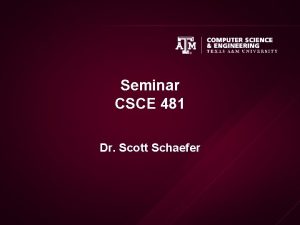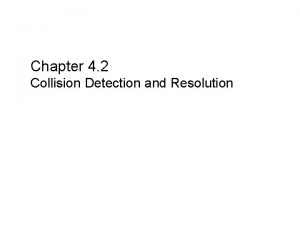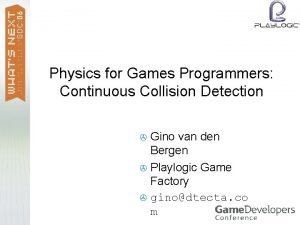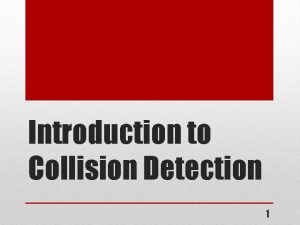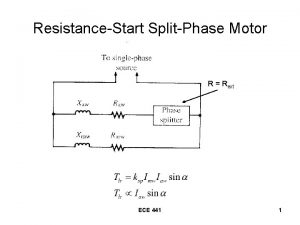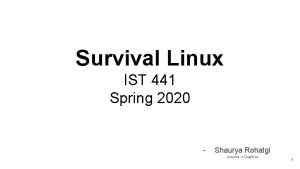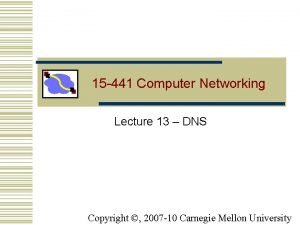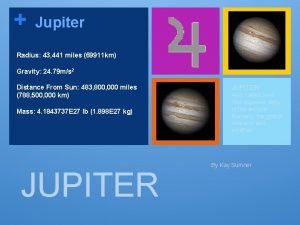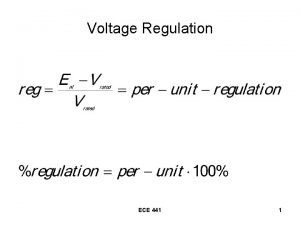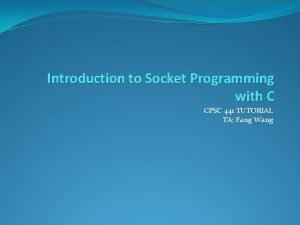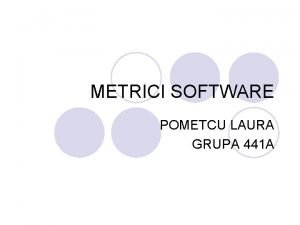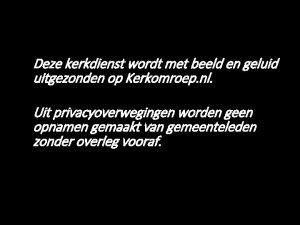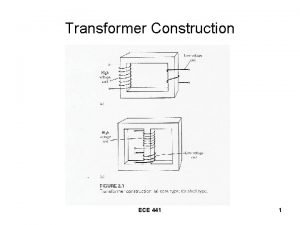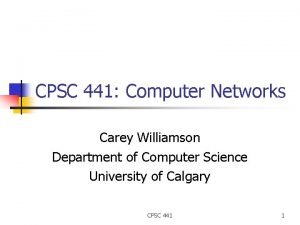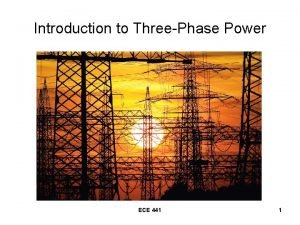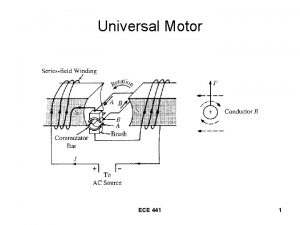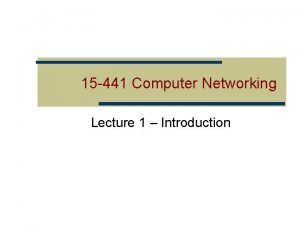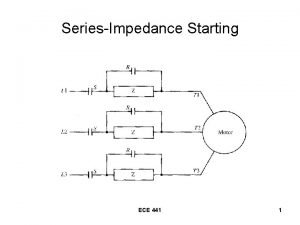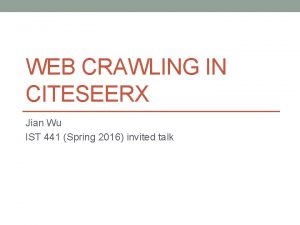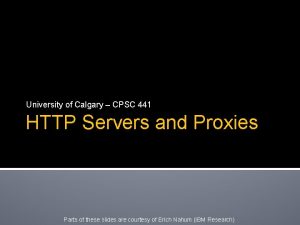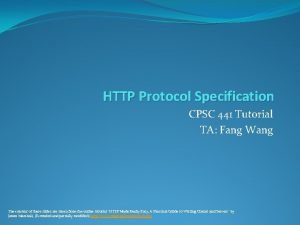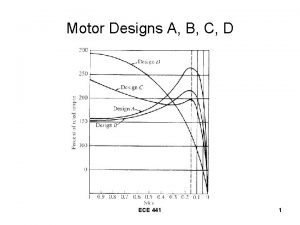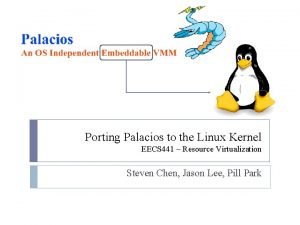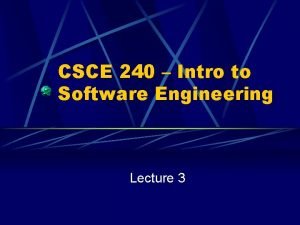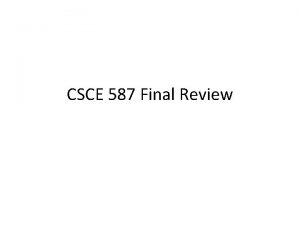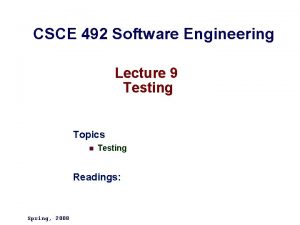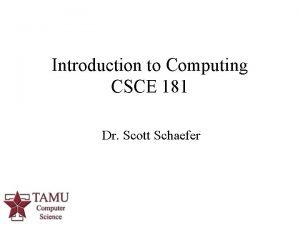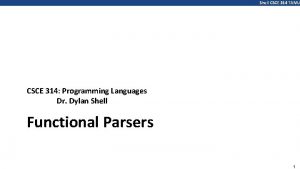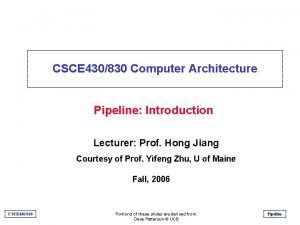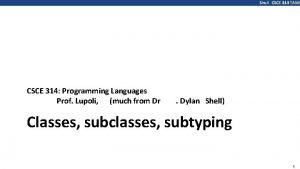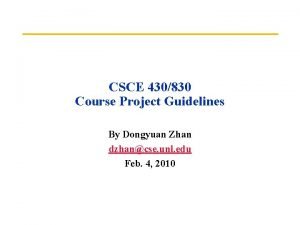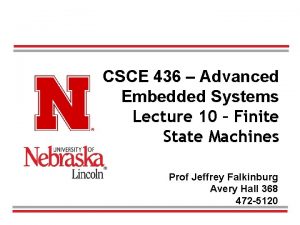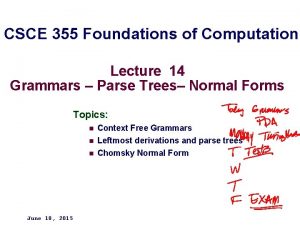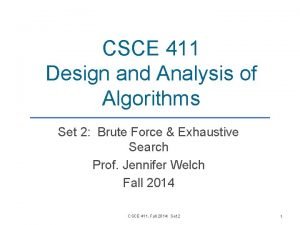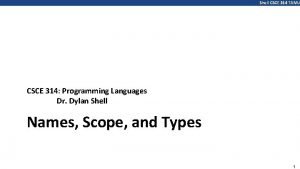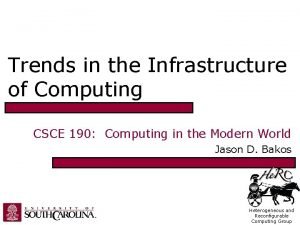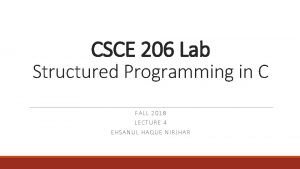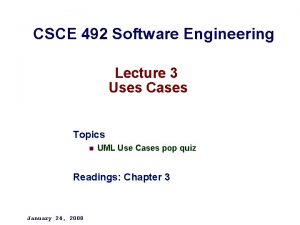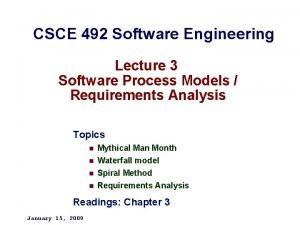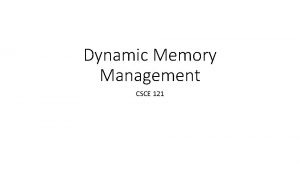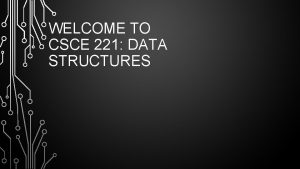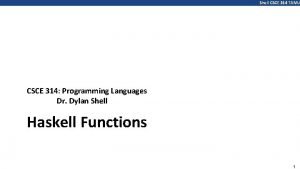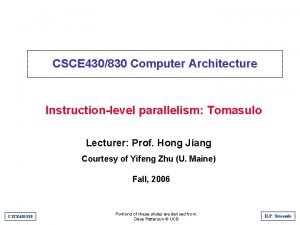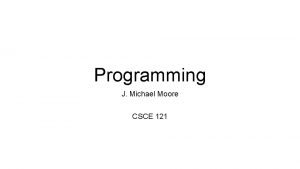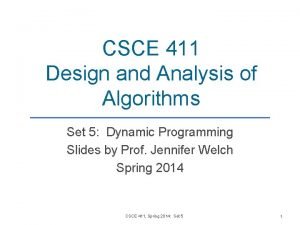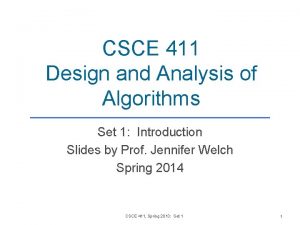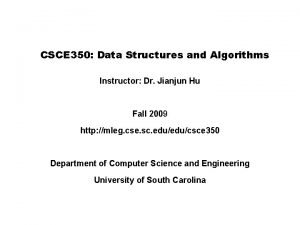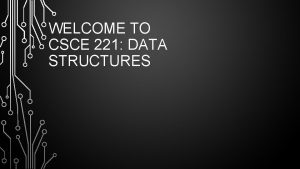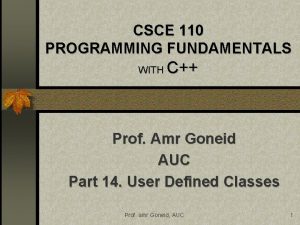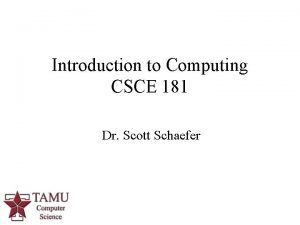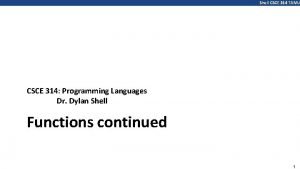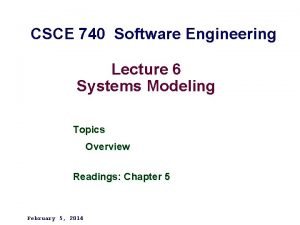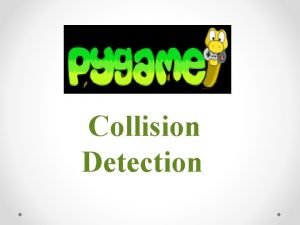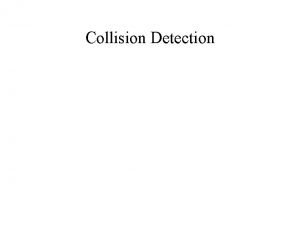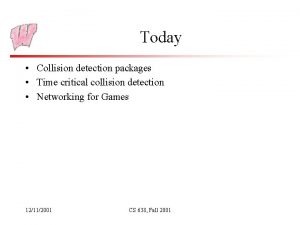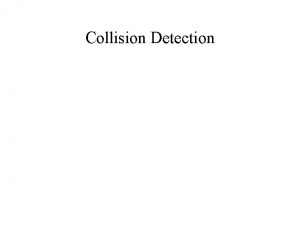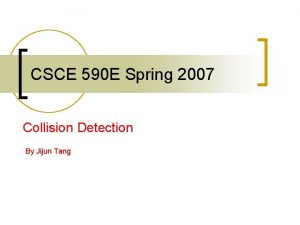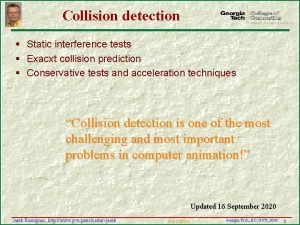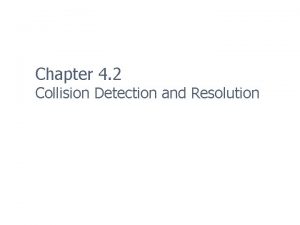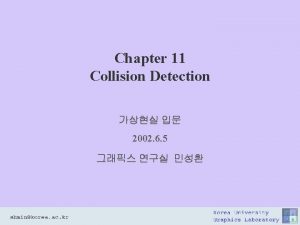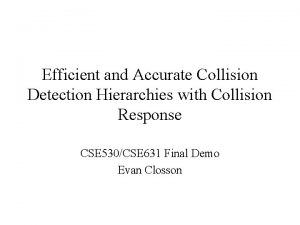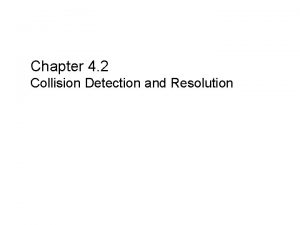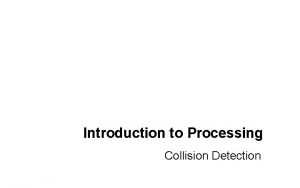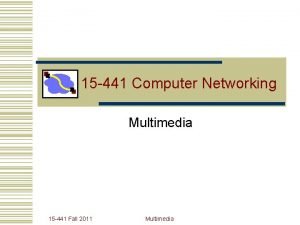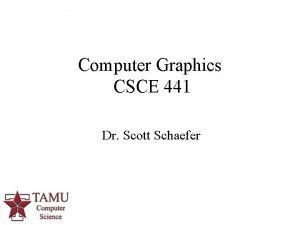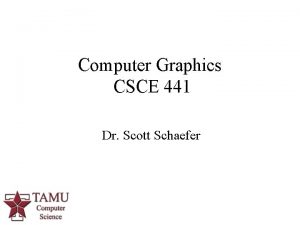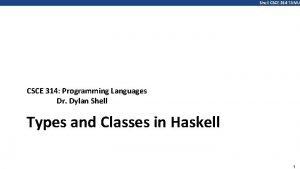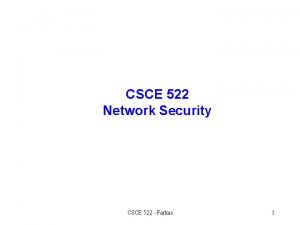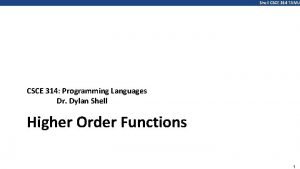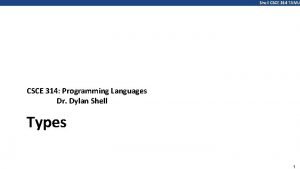Collision Detection CSCE 441 What is Collision Detection




























































- Slides: 60

Collision Detection CSCE 441

What is Collision Detection? § Given two geometric objects, determine if they overlap. § Typically, at least one of the objects is a set of triangles. w Rays/lines w Planes w Polygons w Frustums w Spheres w Curved surfaces 2/60

When Used § Often in simulations w Objects move – find when they hit something else § Other examples w Ray tracing speedup w Culling objects/classifying objects in regions § Usually, needs to be fast w Applied to lots of objects, often in real-time applications 3/60

Bounding Volumes § Key idea: w Surround the object with a (simpler) bounding object (the bounding volume). w If something does not collide with the bounding volume, it does not collide with the object inside. w Often, to intersect two objects, first intersect their bounding volumes 4/60

Choosing a Bounding Volume § Lots of choices, each with tradeoffs 5/60

Choosing a Bounding Volume § Lots of choices, each with tradeoffs § Tighter fitting is better w More likely to eliminate “false” intersections 6/60

Choosing a Bounding Volume § Lots of choices, each with tradeoffs § Tighter fitting is better § Simpler shape is better w Makes it faster to compute with 7/60

Choosing a Bounding Volume § § Lots of choices, each with tradeoffs Tighter fitting is better Simpler shape is better Rotation Invariant is better w Easier to update as object moves 8/60

Choosing a Bounding Volume § § § Lots of choices, each with tradeoffs Tighter fitting is better Simpler shape is better Rotation Invariant is better Convex is usually better w Gives simpler shape, easier computation 9/60

Common Bounding Volumes: Sphere § Rotationally invariant w Usually § Usually fast to compute with § Store: center point and radius w Center point: object’s center of mass w Radius: distance of farthest point on object from center of mass. § Often not very tight fit 10/60

Common Bounding Volumes: Axis Aligned Bounding Box (AABB) § Very fast to compute with § Store: max and min along x, y, z axes. w Look at all points and record max, min § Moderately tight fit § Must update after rotation, unless a loose box that encompasses the bounding sphere 11/60

Common Bounding Volumes: k-dops § k-discrete oriented polytopes § Same idea as AABBs, but use more axes. § Store: max and min along fixed set of axes. w Need to project points onto other axes. § Tighter fit than AABB, but also a bit more work. 12/60

Choosing axes for k-dops § Common axes: consider axes coming out from center of a cube: § Through faces: 6 -dop w same as AABB § Faces and vertices: 14 -dop § Faces and edge centers: 18 -dop § Faces, vertices, and edge centers; 26 dop § More than that not really helpful § Empirical results show 14 or 18 -dop performs best. 13/60

Common Bounding Volumes: Oriented Bounding Box (OBB) § Store rectangular parallelepiped oriented to best fit the object § Store: w Center w Orthonormal set of axes w Extent along each axis § Tight fit, but takes work to get good initial fit § OBB rotates with object, therefore only rotation of axes is needed for update § Computation is slower than for AABBs, but not as bad as it might seem 14/60

Common Bounding Volumes: Convex Hull § Very tight fit (tightest convex bounding volume) § Slow to compute with § Store: set of polygons forming convex hull § Can rotate CH along with object. § Can be efficient for some applications 15/60

Testing for Collision § Will depend on type of objects and bounding volumes. § Specialized algorithms for each: w Sphere/sphere w AABB/AABB w OBB/OBB w Ray/sphere w Triangle/Triangle 16/60

Collision Test Example Sphere-Sphere § Find distance between centers of spheres § Compare to sum of sphere radii w If distance is less, they collide § For efficiency, check squared distance vs. square of sum of radii d r 2 r 1 17/60

Collision Test Example AABB vs. AABB § Project AABBs onto axes w i. e. look at extents § If overlapping on all axes, the boxes overlap. § Same idea for k-dops. 18/60

Collision Test Example OBB vs. OBB § How do we determine if two oriented bounding boxes overlap? 19/60

Separating Axis Theorem § Two convex shapes do not overlap if and only if there exists an axis such that the projections of the two shapes do not overlap 20/60

Enumerating Separating Axes § 2 D: check axis aligned with normal of each face § 3 D: check axis aligned with normals of each face and cross product of each pair of edges 21/60

Enumerating Separating Axes § 2 D: check axis aligned with normal of each face § 3 D: check axis aligned with normals of each face and cross product of each pair of edges 22/60

Enumerating Separating Axes § 2 D: check axis aligned with normal of each face § 3 D: check axis aligned with normals of each face and cross product of each pair of edges 23/60

Enumerating Separating Axes § 2 D: check axis aligned with normal of each face § 3 D: check axis aligned with normals of each face and cross product of each pair of edges 24/60

Enumerating Separating Axes § 2 D: check axis aligned with normal of each face § 3 D: check axis aligned with normals of each face and cross product of each pair of edges 25/60

Collision Test Example Triangle-Triangle § Many collision detection tests eventually reduce to this. § Two common approaches. Both involve finding the plane a triangle lies in. w Cross product of edges to get triangle normal. w This is the plane normal [A B C] where plane is Ax+By+Cz+D=0 w Solve for D by plugging in a triangle vertex 26/60

Triangle-Triangle Collision 1 § Find line of intersection between triangle planes. § Find extents of triangles along this line § If extents overlap, triangles intersect. 27/60

Triangle-Triangle Collision 2 § Intersect edges of one triangle with plane of the other triangle. § 2 edges will intersect – form line segment in plane. § Test that 2 D line segment against triangle. 28/60

Bounding Volume Hierarchies § What happens when the bounding volumes do intersect? w We must test whether the actual objects underneath intersect. w For an object made from lots of polygons, this is complicated. w So, we will use a bounding volume hierarchy 29/60

Bounding Volume Hierarchies § Highest level of hierarchy – single BV around whole object § Next level – subdivide the object into two (or maybe more) parts. w Each part gets its own BV § Continue recursively until only one triangle remains 30/60

Bounding Volume Hierarchy Example 31/60

Bounding Volume Hierarchy Example 32/60

Bounding Volume Hierarchy Example 33/60

Bounding Volume Hierarchy Example 34/60

Bounding Volume Hierarchy Example 35/60

Bounding Volume Hierarchy Example 36/60

Bounding Volume Hierarchy Example 37/60

Bounding Volume Hierarchy Example 38/60

Bounding Volume Hierarchy Example 39/60

Bounding Volume Hierarchy Example 40/60

Bounding Volume Hierarchy Example 41/60

Bounding Volume Hierarchy Example 42/60

Intersecting Bounding Volume Hierarcies § For object-object collision detection § Keep a queue of potentially intersecting BVs w Initialize with main BV for each object § Repeatedly pull next potential pair off queue and test for intersection. w If that pair intersects, put pairs of children into queue. w If no child for both BVs, test triangles inside § Stop when we either run out of pairs (thus no intersection) or we find an intersecting pair of triangles 43/60

BVH Collision Test example 44/60

BVH Collision Test example 45/60

BVH Collision Test example 46/60

BVH Collision Test example 47/60

BVH Collision Test example 48/60

BVH Collision Test example 49/60

BVH Collision Test example 50/60

BVH Collision Test example 51/60

BVH Collision Test example 52/60

BVH Collision Test example 53/60

BVH Collision Test example 54/60

BVH Collision Test example 55/60

Broad Phase vs. Narrow Phase § What we have talked about so far is the “narrow phase” of collision detection. w Testing whether two particular objects collide § The “broad phase” assumes we have a number of objects, and we want to find out all pairs that collide. § Testing every pair is inefficient 56/60

Broad Phase Collision Detection § Form an AABB for each object § Pick an axis w Sort objects along that axis w Find overlapping pairs along that axis w For overlapping pairs, check along other axes. § Limits the number of object/object tests § Overlapping pairs then sent to narrow phase 57/60

Broad Phase Collision Detection 58/60

Collision Detection in a Physically. Based Simulation § Must account for object motion w Obeys basic physical laws – integration of differential equations § Collision detection: yes/no w Collision determination: where do they intersect w Collision response: how do we adjust the motion of objects in response to collision § Collision determination/response are more difficult, but are key for physically based simulation. 59/60

Some Other Issues § Constructing an optimal BVH § Convergence of BVH (i. e. how fast do the BVs approach the actual object). w OBBs asymptotically better, here § Optimizing individual tests § Handling stacking and rest contacts 60/60
 Csce 481
Csce 481 Broad phase vs narrow phase
Broad phase vs narrow phase Collision detection and resolution
Collision detection and resolution Collide and slide algorithm
Collide and slide algorithm Collision detection discrete vs continuous
Collision detection discrete vs continuous Cd protokol
Cd protokol Convex hull collision detection
Convex hull collision detection Ece
Ece Linux
Linux 15-441 cmu
15-441 cmu Jupiter radius km
Jupiter radius km Ece 441
Ece 441 Cpsc 441 assignment 1
Cpsc 441 assignment 1 Calculati 441-(-15)2
Calculati 441-(-15)2 Lied 433
Lied 433 Dchr paid family leave
Dchr paid family leave Ece 441
Ece 441 Cpsc441
Cpsc441 Ece
Ece Ece
Ece 15-441
15-441 Ece 441
Ece 441 Cpsc 329 u of c
Cpsc 329 u of c Ist 441
Ist 441 Cpsc441
Cpsc441 Cpsc 441
Cpsc 441 Ece 441
Ece 441 Eecs 441
Eecs 441 Csce 240
Csce 240 Csce 211
Csce 211 Csce 211
Csce 211 Csce 587
Csce 587 Csce 492
Csce 492 Csce 181
Csce 181 Csce 314
Csce 314 430830
430830 Tamu csce 314
Tamu csce 314 Dongyuan zhan
Dongyuan zhan Csce 436
Csce 436 Csce 355
Csce 355 Csce 411
Csce 411 Csce 314 tamu
Csce 314 tamu Csce 211
Csce 211 Csce 611
Csce 611 Csce 211
Csce 211 Csce 206 tamu
Csce 206 tamu Csce 492
Csce 492 Lms diagram
Lms diagram Csce 121 tamu
Csce 121 tamu Csce 221 tamu
Csce 221 tamu Csce 314
Csce 314 Csce 430
Csce 430 Csce 121
Csce 121 Csce 411
Csce 411 Csce 411 tamu
Csce 411 tamu Dropbox csce
Dropbox csce Tamu csce 221
Tamu csce 221 Csce 110
Csce 110 Csce 181
Csce 181 Dylan shell tamu
Dylan shell tamu Csce dropbox
Csce dropbox
